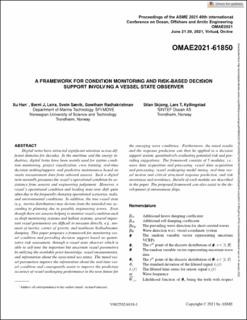| dc.description.abstract | Digital twins have attracted significant attention across different domains for decades. In the maritime and the energy industries, digital twins have been mainly used for system condition monitoring, project visualization, crew training, real-time decision making/support, and predictive maintenance based on onsite measurement data from onboard sensors. Such a digital twin normally presumes the vessel’s operational condition by assistance from sensors and engineering judgement. However, a vessel’s operational condition and loading state may shift quite often due to the frequently changing operational scenarios, tasks, and environmental conditions. In addition, the true vessel state (e.g., inertia distribution) may deviate from the intended one according to planning due to possible engineering errors. Even though there are sensors helping to monitor vessel condition such as draft monitoring systems and ballast systems, several important vessel parameters are difficult to measure directly, e.g., moment of inertia, center of gravity, and nonlinear hydrodynamic damping. This paper proposes a framework for monitoring vessel condition and providing decision support based on quantitative risk assessment, through a vessel state observer which is able to self-tune the important but uncertain vessel parameters by utilizing the available prior knowledge, vessel measurements, and information about the associated sea states. The tuned vessel parameters improve the information about the real-time vessel condition and consequently assist to improve the prediction accuracy of vessel seakeeping performance in the near future for the emerging wave conditions. Furthermore, the tuned results and the response prediction can then be applied to a decision support system, quantitatively evaluating potential risk and providing suggestions. The framework consists of 5 modules, i.e., wave data acquisition and processing, vessel data acquisition and processing, vessel seakeeping model tuning, real-time vessel motion and critical structural response prediction, and risk awareness and avoidance. Details of each module are described in the paper. The proposed framework can also assist in the development of autonomous ships. | en_US |
